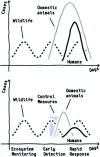The human environment interface: applying ecosystem concepts to health
- PMID: 23633105
- PMCID: PMC7121839
- DOI: 10.1007/82_2013_317
The human environment interface: applying ecosystem concepts to health
Abstract
One Health approaches have tended to focus on closer collaboration among veterinarians and medical professionals, but remain unclear about how ecological approaches could be applied or how they might benefit public health and disease control. In this chapter, we review ecological concepts, and discuss their relevance to health, with an emphasis on emerging infectious diseases (EIDs). Despite the fact that most EIDs originate in wildlife, few studies account for the population, community, or ecosystem ecology of the host, reservoir, or vector. The dimensions of ecological approaches to public health that we propose in this chapter are, in essence, networks of population dynamics, community structure, and ecosystem matrices incorporating concepts of complexity, resilience, and biogeochemical processes.
Figures


Similar articles
-
The historical, present, and future role of veterinarians in One Health.Curr Top Microbiol Immunol. 2013;365:31-47. doi: 10.1007/82_2012_259. Curr Top Microbiol Immunol. 2013. PMID: 22911439 Free PMC article.
-
[One Health--mutual health of humans, animals and the environment].Duodecim. 2016;132(13-14):1223-9. Duodecim. 2016. PMID: 27522830 Review. Finnish.
-
The concept of one health applied to the problem of zoonotic diseases.Rev Med Virol. 2022 Jul;32(4):e2326. doi: 10.1002/rmv.2326. Epub 2022 Jan 20. Rev Med Virol. 2022. PMID: 35060214 Review.
-
Zoonoses: beyond the human-animal-environment interface.Lancet. 2020 Jul 4;396(10243):1. doi: 10.1016/S0140-6736(20)31486-0. Lancet. 2020. PMID: 32622381 No abstract available.
-
The use of animals as a surveillance tool for monitoring environmental health hazards, human health hazards and bioterrorism.Vet Microbiol. 2017 May;203:40-48. doi: 10.1016/j.vetmic.2017.02.007. Epub 2017 Feb 17. Vet Microbiol. 2017. PMID: 28619165 Free PMC article. Review.
Cited by
-
The One Health approach to identify knowledge, attitudes and practices that affect community involvement in the control of Rift Valley fever outbreaks.PLoS Negl Trop Dis. 2017 Feb 16;11(2):e0005383. doi: 10.1371/journal.pntd.0005383. eCollection 2017 Feb. PLoS Negl Trop Dis. 2017. PMID: 28207905 Free PMC article.
-
Communicating the interdependence of human, animal, and environmental health on X (formerly Twitter): Insights from the one health approach.iScience. 2024 Dec 15;28(1):111606. doi: 10.1016/j.isci.2024.111606. eCollection 2025 Jan 17. iScience. 2024. PMID: 39834860 Free PMC article.
-
Improving risk analysis of the environmental drivers of the spillover, emergence/re-emergence and spread of Crimean-Congo haemorrhagic fever virus, Marburg virus and Middle East respiratory syndrome coronavirus in the East Africa Region.BMJ Glob Health. 2025 Apr 16;10(4):e019162. doi: 10.1136/bmjgh-2025-019162. BMJ Glob Health. 2025. PMID: 40240055 Free PMC article. Review.
-
Broad-spectrum antivirals against viral fusion.Nat Rev Microbiol. 2015 Jul;13(7):426-37. doi: 10.1038/nrmicro3475. Epub 2015 Jun 15. Nat Rev Microbiol. 2015. PMID: 26075364 Free PMC article. Review.
-
A Remarkable Genetic Diversity of Rotavirus A Circulating in Red Fox Population in Croatia.Pathogens. 2021 Apr 16;10(4):485. doi: 10.3390/pathogens10040485. Pathogens. 2021. PMID: 33923799 Free PMC article.
References
-
- Azam F, Fenchel T, Field JG, Gray JS, Meyer-Reil LA, Thingstad F. The ecological role of water-column microbes in the sea. Mar Ecol Prog Ser. 1983;10:257–263. doi: 10.3354/meps010257. - DOI
-
- Bardgett RD. The biology of soil: a community and ecosystem approach. New York: Oxford University Press; 2005.
-
- Begon M, Harper JL, Townsend CR. Ecology: individuals, populations and communities. Oxford: Blackwell Science; 1996.
Publication types
MeSH terms
LinkOut - more resources
Full Text Sources
Other Literature Sources
Medical

